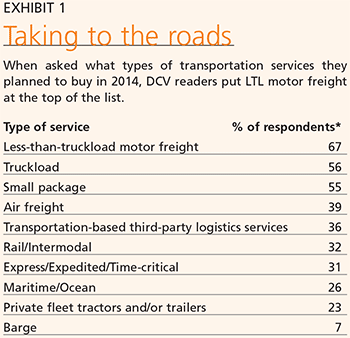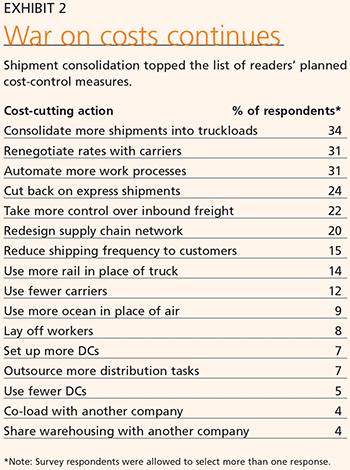Sunnier days ahead for the economy?

So, you say that the sun will finally shine on the economy six years after the Great Recession? That optimistic view of the future direction of the economy was shared by 46 percent of the respondents who took part in DC Velocity's 7th annual "Outlook" survey of its readers.
However, respondents are not ready to spend more on distribution products and services, which include logistics and related products, material handling equipment, information technology, and transportation. About 43 percent said their distribution spend in 2014 would be on par with 2013 spending. Thirty-six percent expect an increase, 10 percent a decrease, and another 11 percent did not know.


The annual survey asks readers about their views on the U.S. economy as well as their plans for buying logistics services and material handling products in the year ahead. This year, 382 DC Velocity readers responded to the poll, which was conducted in November.
Despite the uptick in economic optimism, there's still a core of doubters. However, that universe has shrunk as compared with years past. This year's survey found that only 23 percent of respondents expressed a pessimistic view of the economy in 2014. About 31 percent said they weren't sure. Last year, 34 percent were pessimistic about economic prospects.
Asked to assess the fortunes of their own company, about four out of 10 respondents remained optimistic. Forty-three percent anticipated strong sales growth at their own organization, while 30 percent foresaw flat revenues. Another 21 percent thought company sales would be weak. Six percent had no opinion.
CAUTIOUS APPROACH TO SPENDING
According to the Outlook survey, fewer readers are planning to increase their transportation spending than there were a year ago. While 55 percent of respondents to the previous year's survey planned to spend more on transportation in 2013, only 39 percent said they would spend more in 2014. In fact, 40 percent said transportation spending would stay flat, while 10 expect a decrease. (Another 11 percent don't know.)
Of those planning to spend more on transportation, 47 percent said the increase would average between 3 and 5 percent. Another 30 percent said they expected a 1- to 2-percent increase. About 13 percent expect to spend 5 to 9 percent more. About 10 percent said they expect to boost spending by more than 10 percent.
As for what services they plan to buy, the lineup hasn't changed much in recent years. As has been the case with the past three surveys, less-than-truckload (LTL) services topped the list of planned transportation expenditures. Sixty-seven percent of respondents said they would purchase LTL services in 2014. Fifty-six percent said they would use truckload carriers, while another 55 percent said they would buy small-package shipping services. (See Exhibit 1 for the full breakdown of planned transportation expenditures.)
Trucking costs are closely tied to diesel prices and shipping capacity, so our survey asked respondents for their take on these topics. Despite declines in crude oil prices to under $100 a barrel at the time of the survey, respondents are not convinced of the oil market's stability. Eighty-one percent said they believed oil prices would rise in 2014, leading to higher diesel fuel prices. And in spite of a barrage of media reports about a looming freight capacity shortage, 53 percent of respondents said they expect capacity to remain ample. Thirty-one percent are unsure, and only 16 percent expect a freight capacity shortage.
When asked for their reasons, about one-third of the respondents said carriers would find a way to maintain adequate capacity and deliver on their service commitments. Another one-third said the sub-par economic recovery has muted freight demand and kept supply flush.
CONTROLLING COSTS THROUGH AUTOMATION
Survey takers were also asked about their planned use of contract logistics services in 2014. Fifty-two percent will not use third-party logistics services, compared with 48 percent that will. Of those respondents hiring third-party logistics service providers (3PLs), 31 percent planned to increase their use of contract services. Fifty-nine percent said their use of 3PLs would stay the same, while 10 percent expected to curtail their outsourcing activity.
As for spending on material handling products and services, racks and shelving led the list of planned purchases, cited by 42 percent. Second on the list were safety products, named by 40 percent. Third was lift trucks, at 36 percent.
When it comes to planned software purchases, warehouse management systems (WMS) topped the list, just as they did last year. Twenty-five percent expect to buy a WMS and another 18 percent a transportation management system (TMS). Inventory optimization systems placed third, with 16 percent.
Automation appears to be gaining ground as a way for companies to hold down distribution spending. Although the tried-and-true method of consolidating LTL shipments into truckloads topped the list of planned cost-control measures, at 34 percent, carrier rate renegotiation and automation of more work processes were close behind, tied at 31 percent. The third-most cited approach was cutting back on express shipments, cited by 24 percent.
The plurality of respondents in the 2013 poll came from manufacturing, at 34 percent of the overall total. Distributors, 31 percent, were the second largest sector represented. The remainder worked for logistics service providers (18 percent), retailers (9 percent), or other types of businesses (9 percent).
Related Articles

Copyright ©2024. All Rights ReservedDesign, CMS, Hosting & Web Development :: ePublishing